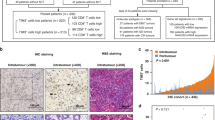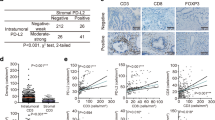Abstract
Background
The molecular driving forces of anti-tumor immunity in pancreatic ductal adenocarcinoma (PDAC) remain unclear, which causing great difficulty in identifying an appropriate treatment strategy.
Aims
This study aims to explore the associations between expression of Wilms tumor 1-associated protein (WTAP) and effector T-cell infiltration in PDAC.
Methods
In this study, we explored the association between WTAP expression and infiltration level of CD8+ T cells in PDAC. 178 PDAC samples were selected from The Cancer Genome Atlas (TCGA) database. The associations between diverse immune-cell infiltration, Tumor Mutation Burden (TMB), immune checkpoints, and WTAP expression were performed via R software. Transcriptional hallmarks of anti-tumor immunity and known T-cell-inflamed signature of PDAC were both selected to explore the relevance to WTAP expression. Potential immune checkpoint blockade (ICB) response to different WTAP expression was predicted with tumor immune dysfunction and exclusion (TIDE) algorithm.
Results
WTAP was closely linked to CD8+ T-cell infiltration (r ≥ 0.5, P value < 0.05) and did not show notable association with TMB in PDAC. WTAP positively linked to T-cell-inflamed gene expression profiles (GEP) (IL2RB, IL2RA, ZAP70, ITK, CD3E, CD38, CD27, CD276, CD8A, CMKLR1, CXCR6, HLA-DQA1, HLA-DRB1, HLA-E, NKG7, and STAT1), cytolytic activity (GZMA and PRF1), various immune checkpoints (IDO1, CD274, HAVCR2, PDCD1, CTLA4, LAG3, and PDCD1LG2) and 4-chemokine signature (CCL4, CCL5, CXCL9, and CXCL10). Besides, increased expression of WTAP was related to a higher TIDE score.
Conclusions
WTAP marks PDAC tumors with an active anti-tumor phenotype and might help the identification of PDAC patients who might benefit from immunotherapies.




Similar content being viewed by others
Data availability
The datasets are available in the TCGA database (https://tcga-data.nci.nih.gov/tcga).
References
Arnold M, Abnet CC, Neale RE et al. Global burden of 5 major types of gastrointestinal cancer. Gastroenterology 2020;159:335–349.e15.
Rawla P, Sunkara T, Gaduputi V. Epidemiology of pancreatic cancer: global trends, etiology and risk factors. World J Oncol. 2019;10:10–27.
Trujillo JA, Sweis RF, Bao R, Luke JJ. T cell-inflamed versus non-T cell-inflamed tumors: a conceptual framework for cancer immunotherapy drug development and combination therapy selection. Cancer Immunol Res. 2018;6:990–1000.
Hegde PS, Karanikas V, Evers S. The where, the when, and the how of immune monitoring for cancer immunotherapies in the era of checkpoint inhibition. Clin Cancer Res. 2016;22:1865–1874.
Gubin MM, Zhang X, Schuster H et al. Checkpoint blockade cancer immunotherapy targets tumour-specific mutant antigens. Nature 2014;515:577–581.
Desrosiers R, Friderici K, Rottman F. Identification of methylated nucleosides in messenger RNA from Novikoff hepatoma cells. Proc Natl Acad Sci U S A. 1974;71:3971–3975.
Little NA, Hastie ND, Davies RC. Identification of WTAP, a novel Wilms’ tumour 1-associating protein. Hum Mol Genet. 2000;9:2231–2239.
Horiuchi K, Umetani M, Minami T et al. Wilms’ tumor 1-associating protein regulates G2/M transition through stabilization of cyclin A2 mRNA. Proc Natl Acad Sci U S A. 2006;103:17278–17283.
Horiuchi K, Kawamura T, Iwanari H et al. Identification of Wilms’ tumor 1-associating protein complex and its role in alternative splicing and the cell cycle. J Biol Chem. 2013;288:33292–33302.
Chen Y, Peng C, Chen J et al. WTAP facilitates progression of hepatocellular carcinoma via m6A-HuR-dependent epigenetic silencing of ETS1. Mol Cancer. 2019;18:127.
Tang J, Wang F, Cheng G et al. Wilms’ tumor 1-associating protein promotes renal cell carcinoma proliferation by regulating CDK2 mRNA stability. J Exp Clin Cancer Res. 2018;37:40.
Jo HJ, Shim HE, Han ME et al. WTAP regulates migration and invasion of cholangiocarcinoma cells. J Gastroenterol. 2013;48:1271–1282.
Yi M, Jiao D, Xu H et al. Biomarkers for predicting efficacy of PD-1/PD-L1 inhibitors. Mol Cancer. 2018;17:129.
Chen Y, Zhao J. Identification of an immune gene signature based on tumor microenvironment characteristics in colon adenocarcinoma. Cell Transplant. 2021;30:9636897211001314.
Wong P, Pamer EG. CD8 T cell responses to infectious pathogens. Annu Rev Immunol. 2003;21:29–70.
Sturm G, Finotello F, List M. Immunedeconv: an R package for unified access to computational methods for estimating immune cell fractions from bulk RNA-sequencing data. Methods Mol Biol. 2020;2120:223–232.
Aran D, Hu Z, Butte AJ. xCell: digitally portraying the tissue cellular heterogeneity landscape. Genome Biol. 2017;18:220.
Cristescu R, Mogg R, Ayers M et al. Pan-tumor genomic biomarkers for PD-1 checkpoint blockade-based immunotherapy. Science. 2018;362:eaar3593.
Ayers M, Lunceford J, Nebozhyn M et al. IFN-γ-related mRNA profile predicts clinical response to PD-1 blockade. J Clin Invest. 2017;127:2930–2940.
Murphy KA, Griffith TS. CD8 T cell-independent antitumor response and its potential for treatment of malignant gliomas. Cancers (Basel). 2016;8:71.
Reiser J, Banerjee A. Effector, memory, and dysfunctional CD8(+) T cell fates in the antitumor immune response. J Immunol Res. 2016;2016:8941260.
Li T, Fu J, Zeng Z et al. TIMER2.0 for analysis of tumor-infiltrating immune cells. Nucleic Acids Res. 2020;48:W509–W514.
Schreiber RD, Old LJ, Smyth MJ. Cancer immunoediting: integrating immunity’s roles in cancer suppression and promotion. Science. 2011;331:1565–1570.
Jiang P, Gu S, Pan D et al. Signatures of T cell dysfunction and exclusion predict cancer immunotherapy response. Nat Med. 2018;24:1550–1558.
Romero JM, Grünwald B, Jang GH et al. A four-chemokine signature is associated with a T-cell-inflamed phenotype in primary and metastatic pancreatic cancer. Clin Cancer Res. 2020;26:1997–2010.
Spranger S. Mechanisms of tumor escape in the context of the T-cell-inflamed and the non-T-cell-inflamed tumor microenvironment. Int Immunol. 2016;28:383–391.
Dominissini D, Moshitch-Moshkovitz S, Schwartz S et al. Topology of the human and mouse m6A RNA methylomes revealed by m6A-seq. Nature. 2012;485:201–206.
Li BQ, Huang S, Shao QQ et al. WT1-associated protein is a novel prognostic factor in pancreatic ductal adenocarcinoma. Oncol Lett. 2017;13:2531–2538.
Zhuo ZJ, Hua RX, Chen Z et al. WTAP gene variants confer hepatoblastoma susceptibility: a seven-center case-control study. Mol Ther Oncolytics. 2020;18:118–125.
Jiang X, Xu J, Liu M et al. Adoptive CD8+ T cell therapy against cancer: challenges and opportunities. Cancer Lett. 2019;462:23–32.
Farhood B, Najafi M, Mortezaee K. CD8+ cytotoxic T lymphocytes in cancer immunotherapy: a review. J Cell Physiol. 2019;234:8509–8521.
Huang L, Ye K, McGee MC et al. Interleukin-2-inducible t-cell kinase deficiency impairs early pulmonary protection against Mycobacterium tuberculosis infection. Front Immunol. 2020;10:3103.
Liao XC, Littman DR. Altered T cell receptor signaling and disrupted T cell development in mice lacking Itk. Immunity. 1995;3:757–769.
Joo J, Omae Y, Hitomi Y et al. The association of integration patterns of human papilloma virus and single nucleotide polymorphisms on immune- or DNA repair-related genes in cervical cancer patients. Sci Rep. 2019;9:13132.
Shen T, Chen Z, Zhao ZJ, Wu J. Genetic defects of the IRF1-mediated major histocompatibility complex class I antigen presentation pathway occur prevalently in the JAK2 gene in non-small cell lung cancer. Oncotarget. 2017;8:60975–60986.
Banchereau J, Steinman RM. Dendritic cells and the control of immunity. Nature. 1998;392:245–252.
Moisini I, Davidson A. BAFF: a local and systemic target in autoimmune diseases. Clin Exp Immunol. 2009;158:155–163.
Edwards DR, Handsley MM, Pennington CJ. The ADAM metalloproteinases. Mol Aspects Med. 2008;29:258–289.
Humphris JL, Patch AM, Nones K et al. Hypermutation in pancreatic cancer. Gastroenterology. 2017;152:68-74.e2.
Joosten SA, van Meijgaarden KE, Savage ND et al. Identification of a human CD8+ regulatory T cell subset that mediates suppression through the chemokine CC chemokine ligand 4. Proc Natl Acad Sci U S A. 2007;104:8029–8034.
Pham K, Luo D, Liu C, Harrison JK. CCL5, CCR1 and CCR5 in murine glioblastoma: immune cell infiltration and survival rates are not dependent on individual expression of either CCR1 or CCR5. J Neuroimmunol. 2012;246:10–17.
Gao JL, Wynn TA, Chang Y et al. Impaired host defense, hematopoiesis, granulomatous inflammation and type 1-type 2 cytokine balance in mice lacking CC chemokine receptor 1. J Exp Med. 1997;185:1959–1968.
Auerbuch V, Brockstedt DG, Meyer-Morse N, O’Riordan M, Portnoy DA. Mice lacking the type I interferon receptor are resistant to Listeria monocytogenes. J Exp Med. 2004;200:527–533.
Whiting D, Hsieh G, Yun JJ et al. Chemokine monokine induced by IFN-gamma/CXC chemokine ligand 9 stimulates T lymphocyte proliferation and effector cytokine production. J Immunol. 2004;172:7417–7424.
Peng D, Kryczek I, Nagarsheth N et al. Epigenetic silencing of TH1-type chemokines shapes tumour immunity and immunotherapy. Nature. 2015;527:249–253.
Funding
None.
Author information
Authors and Affiliations
Contributions
JX: Conceptualization, methodology, software, data curation, formal analysis, investigation, validation, writing-original draft.
Corresponding author
Ethics declarations
Conflict of interest
The author declares no conflict of interest.
Ethical approval
Not applicable.
Consent to participate
Not applicable.
Consent to publish
Not applicable.
Additional information
Publisher's Note
Springer Nature remains neutral with regard to jurisdictional claims in published maps and institutional affiliations.
Rights and permissions
About this article
Cite this article
Xu, Jl. Wilms Tumor 1-Associated Protein Expression Is Linked to a T-Cell-Inflamed Phenotype in Pancreatic Cancer. Dig Dis Sci 68, 831–840 (2023). https://doi.org/10.1007/s10620-022-07620-7
Received:
Accepted:
Published:
Issue Date:
DOI: https://doi.org/10.1007/s10620-022-07620-7




